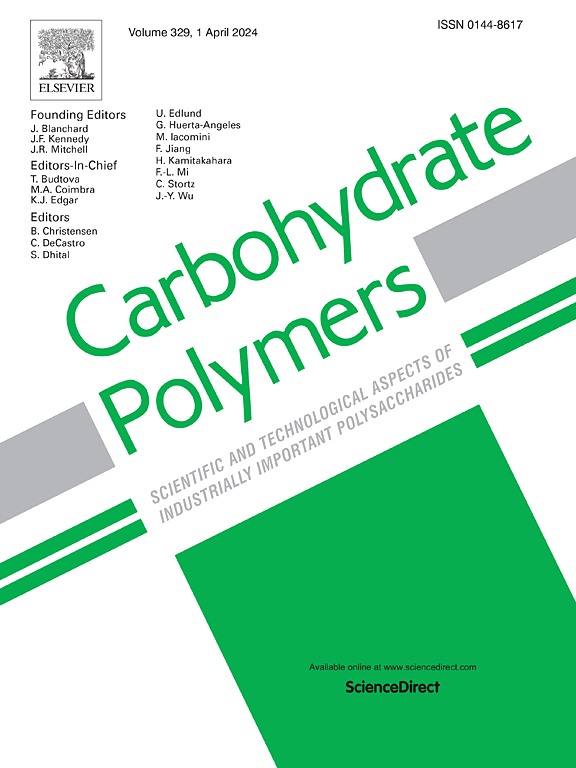Konjac glucomannan/Bletilla striata polysaccharide composite hydrogel: A promising anti-inflammatory dressing for accelerated wound healing
IF 10.7
1区 化学
Q1 CHEMISTRY, APPLIED
引用次数: 0
Abstract
A hydrogel with remarkable anti-inflammatory properties holds significant potential for accelerating wound healing. This study focuses on developing a safe and effective wound-healing hydrogel based on polysaccharides. The hydrogel was synthesized by cross-linking Konjac Glucomannan (KGM) and Bletilla Striata Polysaccharide (BSP) using 1,4-Butanediol Diglycidyl Ether (BDDE) and subsequently evaluated as a wound dressing. Compared to hydrogels cross-linked solely with KGM, the co-crosslinked KGM-BSP hydrogel demonstrated superior water retention, enhanced mechanical strength (maximum tensile stress: 6.6 kPa), excellent adhesive properties (maximum shear stress: 848.53 ± 31.4 Pa), and outstanding biocompatibility.
Moreover, in vitro anti-inflammatory assays revealed that the KGM-BSP hydrogel effectively inhibited the activation of the TNF-α/NF-κB pathway while upregulating IL-10 expression, thereby mitigating inflammation and facilitating tissue repair during wound healing. Scratch and Western blot assays further indicated that the hydrogel significantly enhanced the migratory capacity of L929 cells by activating the Rho GTPase pathway.
In a mouse wound model, the KGM-BSP hydrogel reduced inflammation, promoted angiogenesis, and stimulated collagen deposition, collectively accelerating wound closure. These findings suggest that the KGM-BSP composite hydrogel is a highly promising wound dressing with the potential to markedly enhance the wound healing process.

魔芋葡甘露聚糖/白芨多糖复合水凝胶:一种有前途的抗炎敷料,加速伤口愈合
具有显著抗炎特性的水凝胶具有显著的加速伤口愈合的潜力。本研究的重点是开发一种安全有效的基于多糖的伤口愈合水凝胶。以1,4-丁二醇二缩水甘油醚(BDDE)为原料,将魔芋葡甘露聚糖(KGM)与白芨多糖(BSP)交联合成水凝胶,并评价其作为伤口敷料的应用价值。与仅与KGM交联的水凝胶相比,共交联的KGM- bsp水凝胶具有更好的保水性,增强的机械强度(最大拉伸应力:6.6 kPa),优异的粘接性能(最大剪切应力:848.53±31.4 Pa),以及出色的生物相容性。此外,体外抗炎实验显示,KGM-BSP水凝胶可以有效抑制TNF-α/NF-κB通路的激活,同时上调IL-10的表达,从而减轻炎症,促进伤口愈合过程中的组织修复。划痕和Western blot实验进一步表明,水凝胶通过激活Rho GTPase通路,显著增强了L929细胞的迁移能力。在小鼠伤口模型中,KGM-BSP水凝胶减少炎症,促进血管生成,刺激胶原沉积,共同加速伤口愈合。这些结果表明,KGM-BSP复合水凝胶是一种非常有前途的伤口敷料,具有显著促进伤口愈合过程的潜力。
本文章由计算机程序翻译,如有差异,请以英文原文为准。
求助全文
约1分钟内获得全文
求助全文
来源期刊

Carbohydrate Polymers
化学-高分子科学
CiteScore
22.40
自引率
8.00%
发文量
1286
审稿时长
47 days
期刊介绍:
Carbohydrate Polymers stands as a prominent journal in the glycoscience field, dedicated to exploring and harnessing the potential of polysaccharides with applications spanning bioenergy, bioplastics, biomaterials, biorefining, chemistry, drug delivery, food, health, nanotechnology, packaging, paper, pharmaceuticals, medicine, oil recovery, textiles, tissue engineering, wood, and various aspects of glycoscience.
The journal emphasizes the central role of well-characterized carbohydrate polymers, highlighting their significance as the primary focus rather than a peripheral topic. Each paper must prominently feature at least one named carbohydrate polymer, evident in both citation and title, with a commitment to innovative research that advances scientific knowledge.
 求助内容:
求助内容: 应助结果提醒方式:
应助结果提醒方式:


